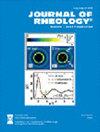Gaborheometry: Applications of the discrete Gabor transform for time resolved oscillatory rheometry
IF 3.2
2区 工程技术
Q2 MECHANICS
引用次数: 1
Abstract
Oscillatory rheometric techniques such as small amplitude oscillatory shear (SAOS) and, more recently, medium amplitude oscillatory shear and large amplitude oscillatory shear (LAOS) are widely used for rheological characterization of the viscoelastic properties of complex fluids. However, in a time-evolving or mutating material, the build-up or breakdown of microstructure is commonly both time- and shear-rate (or shear-stress) dependent, and thixotropic phenomena are observed in many complex fluids including drilling fluids, biopolymer gels, and many food products. Conventional applications of Fourier transforms for analyzing oscillatory data assume the signals are time-translation invariant, which constrains the mutation number of the material to be extremely small. This constraint makes it difficult to accurately study shear-induced microstructural changes in thixotropic and gelling materials, and it is becoming increasingly important to develop more advanced signal processing techniques capable of robustly extracting time-resolved frequency information from oscillatory data. In this work, we explore applications of the Gabor transform (a short-time Fourier transform combined with a Gaussian window), for providing optimal joint time-frequency resolution of a mutating material’s viscoelastic properties. First, we show using simple analytic models and measurements on a bentonite clay that the Gabor transform enables us to accurately measure rapid changes in both the storage and/or loss modulus with time as well as extract a characteristic thixotropic/aging time scale for the material. Second, using the Gabor transform we demonstrate the extraction of useful viscoelastic data from the initial transient response following the inception of oscillatory flow. Finally, we consider extension of the Gabor transform to nonlinear oscillatory deformations using an amplitude-modulated input strain signal, in order to track the evolution of the Fourier–Tschebyshev coefficients of thixotropic fluids at a specified deformation frequency. We refer to the resulting test protocol as Gaborheometry (Gabor-transformed oscillatory shear rheometry). This unconventional, but easily implemented, rheometric approach facilitates both SAOS and LAOS studies of time-evolving materials, reducing the number of required experiments and the data postprocessing time significantly.离散Gabor变换在时间分辨振荡流变学中的应用
振荡流变仪技术,如小振幅振荡剪切(SAOS),以及最近的中振幅振荡剪切和大振幅振荡剪(LAOS),被广泛用于复杂流体粘弹性特性的流变表征。然而,在时间演变或突变的材料中,微观结构的形成或破坏通常与时间和剪切速率(或剪切应力)有关,并且在许多复杂流体中观察到触变现象,包括钻井液、生物聚合物凝胶和许多食品。傅立叶变换用于分析振荡数据的传统应用假设信号是时移不变的,这将材料的突变数限制为极小。这种限制使得准确研究触变和胶凝材料中剪切引起的微观结构变化变得困难,并且开发能够从振荡数据中稳健地提取时间分辨频率信息的更先进的信号处理技术变得越来越重要。在这项工作中,我们探索了Gabor变换(一种与高斯窗口相结合的短时傅立叶变换)的应用,以提供变异材料粘弹性特性的最佳联合时频分辨率。首先,我们在膨润土上使用简单的分析模型和测量表明,Gabor变换使我们能够准确地测量储存模量和/或损失模量随时间的快速变化,并提取材料的触变/老化特征时间尺度。其次,使用Gabor变换,我们证明了从振荡流开始后的初始瞬态响应中提取有用的粘弹性数据。最后,我们考虑使用调幅输入应变信号将Gabor变换扩展到非线性振荡变形,以跟踪触变流体在特定变形频率下的傅立叶–Tschebyshev系数的演变。我们将得到的测试方案称为Gabor流变学(Gabor变换振荡剪切流变仪)。这种非传统但易于实施的流变仪方法有助于SAOS和LAOS对时间演变材料的研究,大大减少了所需的实验次数和数据后处理时间。
本文章由计算机程序翻译,如有差异,请以英文原文为准。
求助全文
约1分钟内获得全文
求助全文
来源期刊

Journal of Rheology
物理-力学
CiteScore
6.60
自引率
12.10%
发文量
100
审稿时长
1 months
期刊介绍:
The Journal of Rheology, formerly the Transactions of The Society of Rheology, is published six times per year by The Society of Rheology, a member society of the American Institute of Physics, through AIP Publishing. It provides in-depth interdisciplinary coverage of theoretical and experimental issues drawn from industry and academia. The Journal of Rheology is published for professionals and students in chemistry, physics, engineering, material science, and mathematics.
 求助内容:
求助内容: 应助结果提醒方式:
应助结果提醒方式:


